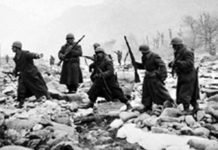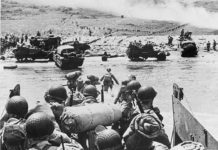During the Indian Wars, the Battle of Powder River equated to a hollow army victory that foreshadowed doom for George Custer at Little Bighorn.
In 1876, one of the most famous battles of the Indian Wars occurred at the Battle of the Little Bighorn and the death of Lt. Colonel George Custer. Prior to that engagement in June, tactical errors in other Indian battles would occur that set the stage for his staggering defeat in present-day Montana. In the Battle of Powder River, the army suffered from a series of blunders that would reveal weaknesses in its tactics and instill boldness in the Cheyenne and Sioux Indians.
The Hunt for Indians
After fruitlessly searching the Tongue River drainage for Indian activity in March 1876, Brigadier General George Crook would take the advice of his trusted scout, Frank Grouard, and lead his column east towards the Powder River. On March 16, with the thermometer hovering at thirty below zero, Crook split his assets. He gave Colonel Joseph Reynolds a strike force of six companies of cavalry and a contingent of scouts to locate and destroy any village found along the river.
Reynolds’ column halted at 2:30 A.M. on March 17 after Grouard reported finding sign of a nearby enemy camp. His men waited in the cold, doing their best to fend off frostbite, for several hours until Grouard returned a second time with news that he had located the camp of some 100 lodges on the banks of the Powder River.
Mistakes at Powder River
Reynolds split his column into three groups. Captain Noyes would lead his men to the camp where half of them, led by Captain Egan, would charge the village while Noyes used the rest to stampede the Indians’ horse herd of 700 animals. Two dismounted companies of cavalry under Captain Moore would cover the surprise attack on the village from the overlooking bluffs while Captain Mills and the remainder of the dismounted cavalry would hold in reserve to assist where needed.
With the command of “left front into line,” Egan’s column charged the Indian village while Noyes successfully drove off the horse herd. The alarmed Sioux and Cheyenne escaped to the surrounding hills with few casualties and commenced firing on Egan. The expected coverage from Moore was delayed in coming as his men initially misjudged where the exact location of the village was and then had difficulty reaching Egan over the steep and broken terrain. Egan’s men were held pinned in the brush next to the river until reinforced by Mills in the camp and later Moore on the hills.
Having secured the area and driven off the Indians, the men commenced burning the village and the large stockpiles of ammunition, gunpowder, and food that it contained. Fearing a counterattack, Reynolds ordered his men to withdraw before vital food and clothing could be taken and the camp completely destroyed. His men would march south frozen and starving; they reunited with Crook at Lodgepole Creek on March 18.
Consequences for Custer at the Little Bighorn
To Crook’s dismay, the win for his army was a dismal one in no small part to the poor leadership exhibited by Reynolds. In the rushed confusion of leaving the village, four dead and one wounded soldier were abandoned to the mercy of the Indians. Sixty-three men in Reynolds’ command suffered frostbite. On the way to Lodgepole Creek, the trailing warriors managed to retake all but 100 of their horses. Most importantly, the Indians were alerted to the presence of the army and vital war materials that could have been captured, utilized or destroyed fell back into enemy hands. These errors not only cost Crook the initiative on this campaign with little to show for it, they also likely contributed to the outcome for Custer and the 7th Cavalry that June against an emboldened enemy with the resources to fight. Following the Battle of Powder River, Crook had no choice but to withdraw his weakened and hungry army south to Fort Fetterman until the arrival of warmer weather.








